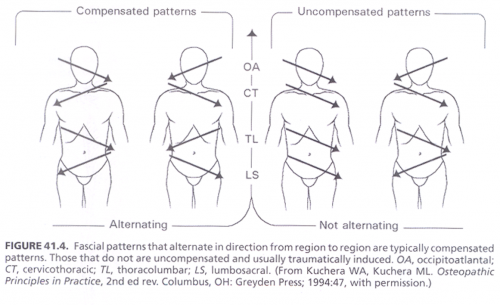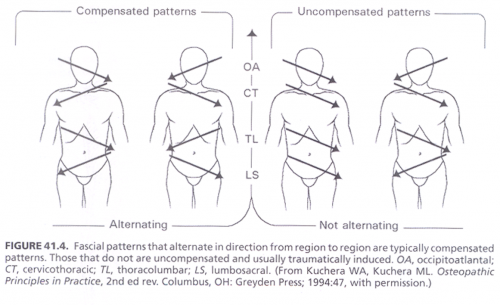Identify the 4 main anatomical transition zones
Craniocervical junction (OA, Occipito-atlantal junction)
Cervicothoracic junction (Thoracic Inlet)
Thoracolumbar junction (Abdominal Diaphragm)
Lumbopelvic junction (Pelvic Diaphragm)

compensated fascial patterns.
An adaptive response in an attempt to maintain function when the posture isn’t ideal.
Provide less than ideal metabolic function because respiratory and circulatory activities are impaired.

Uncompensated patterns
Rotation patterns that do not alternate between each transitional region are uncompensated.
Uncompensated patterns are a greater challenge to the physiologic state and are commonly the result of trauma.

Goals for Osteopathic treatment when using the Respiratory-Circulatory Model
Goal 1: Open myofascial pathways at central transition areas of the body first and then peripheral.
Goal 2: Maximize normal diaphragmatic motions.
Goal 3: Increase pressure differentials or induce motion in order to pump or otherwise augment fluid flow beyond normal levels.
Goal 4: Mobilize targeted tissue fluids into the lymphatico-venous system from going from distal to central.
Know and perform the steps of the Respiratory-Circulatory Screen (12)
Respiratory movement
Leg length
Lumbar spine curvature
ASIS position
ASIS compression test
Lumbosacral transitional region (Lumbopelvic junction)
Thoracolumbar transitional region (Thoracolumbar junction)
Cervicothoracic transitional region (Cervicothoracic junction)
Occipitocervical transitional region (Craniocervical junction)
Shoulder position
Arm length
Areas of passive lymphatic congestion
1. L leg is long
2. Flat lumbar spine
3. R Anterior Superior Iliac Spine (ASIS) is inferior
4. Lumbosacral rotates to R
5. Thoracolumbar rotated to R
6. Cervicothoracic rotated to R
7. occipitocervical rotated to L
8. R arm long
Common compensatory pattern (80%)

Evaluate the diaphragms at the 4 main transition zones.
Palpate and identify tissue texture abnormalities at the 6 main sites of terminal lymphatic drainage.
Supraclavicular space
Epigastric region
Posterior axillary folds
Inguinal region
Popliteal space
Achilles region




